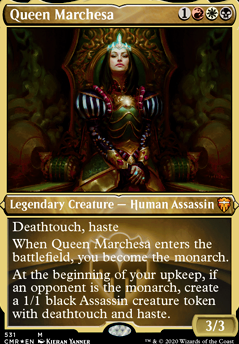Land (36)
- 1x Arid Mesa
- 1x Battlefield Forge
- 1x Blood Crypt
- 1x Bloodstained Mire
- 1x Bojuka Bog
- 1x Caves of Koilos
- 1x City of Brass
-
1x
Command Tower

-
1x
Evolving Wilds

- 1x Fabled Passage
- 1x Fetid Heath
- 1x Godless Shrine
- 1x Graven Cairns
- 1x Mana Confluence
- 1x Marsh Flats
-
2x
Mountain

- 1x Path of Ancestry
-
4x
Plains

- 1x Rugged Prairie
- 1x Sacred Foundry
-
1x
Savai Triome

-
1x
Shattered Landscape

- 1x Sulfurous Springs
-
3x
Swamp

-
1x
Temple of Malice

-
1x
Temple of Silence

-
1x
Temple of Triumph

- 1x Terramorphic Expanse
-
1x
Throne of the High City

-
1x
Treasure Vault

Sorcery (6)
Creature (21)
-
1x
Archon of Coronation

-
1x
Breena, the Demagogue

-
1x
Caesar, Legion's Emperor

- 1x Champions of Minas Tirith
-
1x
Custodi Lich

- 1x Emberwilde Captain
- 1x Grand Abolisher
-
1x
Kambal, Consul of Allocation

-
1x
Kambal, Profiteering Mayor

-
1x
Karazikar, the Eye Tyrant

- 1x Kardur, Doomscourge
-
1x
Kazuul, Tyrant of the Cliffs

- 1x Keeper of the Accord
- 1x Mangara, the Diplomat
- 1x Palace Jailer
-
1x
Protector of the Crown

-
1x
Royal Assassin

-
1x
Skyline Despot

-
1x
Teysa, Envoy of Ghosts

-
1x
Thalia, Heretic Cathar

- 1x Windborn Muse
Instant (13)
Commander (1)
Enchantment (13)
- 1x Anointed Procession
-
1x
Authority of the Consuls

- 1x Black Market Connections
-
1x
Blind Obedience

-
1x
Court of Ambition

-
1x
Court of Grace

-
1x
Court of Ire

- 1x Ghostly Prison
- 1x Land Tax
- 1x Luminarch Ascension
- 1x Phyrexian Arena
- 1x Revel in Riches
- 1x Smothering Tithe
Artifact (9)
-
1x
Arcane Signet

- 1x Boros Signet
-
1x
Commander's Sphere

- 1x Orzhov Signet
- 1x Rakdos Signet
-
1x
Sol Ring

- 1x Talisman of Conviction
- 1x Talisman of Hierarchy
- 1x Talisman of Indulgence
Battle (1)
Suggestions
Updates Add
Comments View Archive
Attention! Complete Comment Tutorial! This annoying message will go away once you do!
Important! Formatting tips — Comment Tutorial — markdown syntax
Please login to comment
99% Casual
Competitive
| Top Ranked |
|
| Date added | 7 years |
| Last updated | 1 day |
| Exclude colors | UG |
| Splash colors | WBR |
| Legality | This deck is Commander / EDH legal. |
| Rarity (main - side) | 7 - 0 Mythic Rares 63 - 0 Rares 13 - 0 Uncommons 8 - 0 Commons |
| Cards | 100 |
| Avg. CMC | 3.48 |
| Tokens | Angel 4/4 W, Assassin 1/1 B w/ Haste, Copy Clone, Dragon 5/5 R, Human Knight 2/2 R, Inkling 2/1 WB, Ogre 3/3 R, Shapeshifter 3/2 C, Soldier 1/1 RW, Soldier 1/1 W, Spirit 1/1 W, Spirit 1/1 WB, Monarch Emblem, Treasure |
| Folders | marchesa ideas, Queen Marchesa, Marchesa, Edh decks, I - Interesting Decks, Her Majesty, Decks, edh, EDH Decks, EDH Decks |
| Votes | |
| Ignored suggestions | |
| Shared with | |
| Views |


